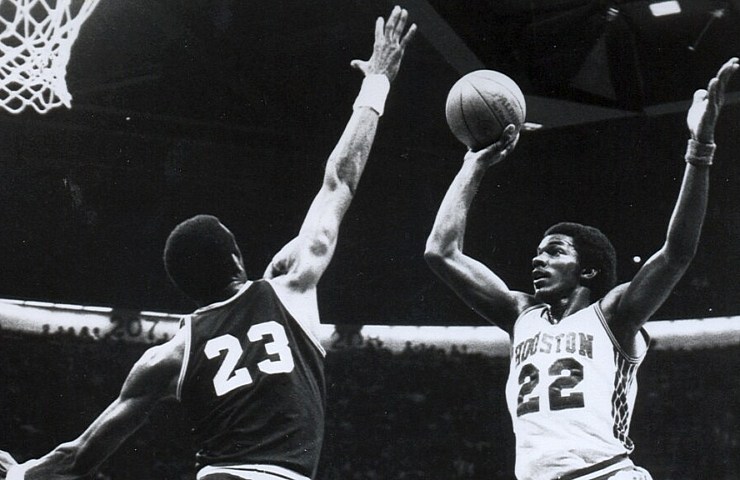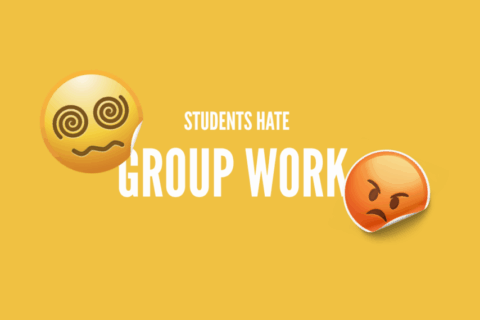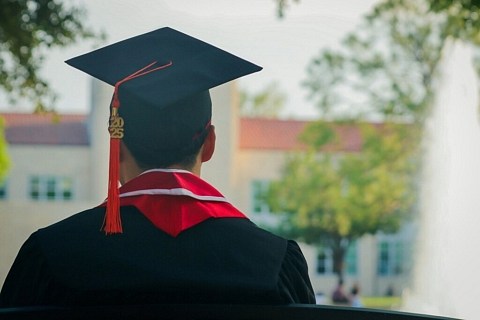Over the years, and especially recently, the Cougar men’s basketball team has been arguably the crown jewel of University of Houston sports.
From winning “The Game of the Century” in 1968 to the high-flying days of “Phi Slama Jama” in the 1980s to the dominant hard-nosed Cougars dominating in Fertitta Center presently under Kelvin Sampson, UH basketball has captivated the nation for decades.
With 29 NCAA Tournament appearances, 22 conference titles, 15 Sweet Sixteens, six Final Four berths and over 2,000 wins between the men’s and women’s teams since 1946 under its belt, Houston Hoops is entering a new era in the Big 12.
But before things get going in a momentous 2023-24 season, let’s take a look at how we got here.
Humble Beginnings (1945-56)
The University of Houston fielded its first basketball team in intercollegiate play in 1945-46 as members of the Lone Star Conference in the National Association of Intercollegiate Athletics, playing its home games in the now-demolished Jeppesen Gymnasium on campus.
Alden Pasche, a local high school coach and physical education professor, was brought on as the team’s first head coach and brought immediate success to the new program.
Pasche’s team, led by team captain center Guy V. Lewis, a World War II veteran from Arp, Texas, won the Lone Star conference title in each of its first seasons and went to the second round of the NAIA Tournament both years.
Three years later in 1950, the Cougars won the Division II Gulf Coast Conference title in its lone year there before becoming an NCAA Division I school a year later.
In 1956, Pasche led UH to a Missouri Valley Conference championship and the team’s first-ever NCAA Tournament, earning a school record 19 wins along the way. After the season, Pasche would retire from coaching. Former player and assistant coach Guy V. Lewis would take the helm.
Though UH women’s basketball had been played on campus since before the men, the Cougars’ women’s hoops squad did not become a varsity sport until 1975, when Houston would earn six postseason trips in its first six seasons in the Association for Intercollegiate Athletics for Women.
Guy V. Lewis Era (1956-86)
In 30 years of running the UH Hoops program, head coach Guy V. Lewis, known for holding a polka dot red-and-white towel during games, always seemed to go against the grain and innovated in ways that changed basketball forever.
In a time when college teams played a slow, ball-control-centric style of basketball before the shot clock was implemented, Lewis encouraged his players to play fast and run on offense for easy dunks, which were frowned upon and later banned in college in the ‘60s and ‘70s.
In 1964, Lewis recruited the program’s first African American players, Don Chaney and Elvin Hayes. As a landmark moment in college sports in the South, UH became one of the first major schools to recruit Black players.
Behind the star power of Chaney and the future Hall of Famer Hayes, Houston made the Tournament Four straight years from 1964-68, including the program’s first two Final Fours in 1967 and 1968.
The Game of the Century
Before the 1967-68 season, Lewis, with the help of athletic director Roy Hofheinz and sports information director Ted Nance, set forth on setting up a monumental, unprecedented skyscraper of a game in January of 1968.
No. 1 UCLA had won three of the last four national titles under legendary head coach John Wooden, and was on a 47-game winning streak. The Bruins walked into the Astrodome to play No. 2 Houston in front of an unheard-of 52,693 fans on January 20, 1968.
It was the first regular-season college basketball game ever to be broadcast nationally, airing on the independent TVS Television Network. Fans from around the country tuned in to watch Elvin “The Big E” Hayes and the Cougars take on the unbeaten, seemingly untouchable Bruins led by superstar 7-foot-2-inch center Lew Alcindor (now known as Kareem Abdul-Jabbar).
The game lived up to its moniker as “The Game of the Century.” Two heavyweights in college basketball exchanged blows for the entire 40 minutes, as Hayes carried the Cougars to a three-point halftime lead.
Hampered by an eye injury from the previous game, Alcindor was held to the worst game of his college career, scoring just 15 points on 4-18 shooting. Meanwhile, Hayes, spurred on by chants of “Big E” by the Houston crowd, established himself as a star on par with Alcindor, scoring 39 points that gave UH a 71-69 lead.
After a missed shot and uncharacteristic turnover by UCLA in the final seconds, the Cougars did the impossible: beat the mighty Bruins.
The game not only launched Houston into mainstream popularity in college basketball, but it changed the sport itself. The nationally televised game was a hit and helped turn college hoops into the nationwide, season-long phenomenon that it is today.
Phi Slama Jama (1981-84)
Lewis and the Cougars stayed solid in the 1970s, notching five more tourney appearances and a Southwest Conference title and producing an NBA All-Star in Otis Birdsong. But in 1981, when 7-foot center Akeem (now Hakeem) Olajuwon arrived in Houston from Nigeria and took the floor with uber-athletic sophomore guard Clyde Drexler, the Cougars shook up the country again.
Drexler, along with All-SWC picks Rob Williams and Michael Young, took Houston all the way to the Final Four as a 6-seed as the first iteration of “Phi Slama Jama,” Texas’ tallest fraternity known for its fast-paced play and electric slam dunks.
A year later, Olajuwon earned a spot on the starting job and quickly became one of the nation’s best big men, fitting perfectly with Lewis’s high-flying style. He earned the nickname “The Dream” due to his smooth, effortless style of play.
Drexler, Olajuwon and company tore up the nation for two straight years on the way to a No. 1 ranking in 1983 and 63 total wins from 1982-84. Soon enough, fans packed Hofheinz Pavillion donning “Phi Slama Jama” shirts to watch Drexler and Olajuwon perform routinely dazzling feats of athleticism and finesse. Both years, UH would make it to the National Championship game, but fell heartbreakingly short twice.
The “Phi Slama Jama” era helped popularize Lewis’s play style of break-neck speed and electric athleticism capitalized by dunks he dubbed as “high percentage shots.”
The Dark Ages (1986-2014)
Drexler and Olajuwon left for the NBA Draft in 1983 and 1984 respectively, going on to have Hall of Fame careers. Olajuwon led the Houston Rockets to two NBA titles in 1994-95, with the latter coming after reuniting with Drexler. Meanwhile, Lewis retired from coaching shortly after the “Phi Slama Jama” days in 1986, marking the end of a magnificent era.
With Lewis’s departure came the collapse of UH basketball, as the men’s team wouldn’t win another NCAA Tournament game for another 34 years.
In nearly three decades, Houston went through seven different basketball coaches, all of which were unable to keep UH Hoops relevant. Pat Foster, Lewis’s successor, and Tom Penders both won conference titles in their tenures at the helm, in 1992 and 2010, but both seasons were cut short by first-round exits in March.
On the women’s side, the Cougars made their first NCAA Tournament in 1988, but wouldn’t win their first game in the Big Dance until 2004, which remains the team’s only tournament win.
Hofheinz Pavilion, which once housed thousands of excited UH fans in the ‘70s and ‘80s, turned into a rundown shell of itself, rarely surpassing more than a few hundred in attendance. Houston basketball had entered the abyss.
Kelvin Sampson’s Revival (2014-present)
After men’s head coach James Dickey resigned after the 2013-14 season, Kelvin Sampson was hired to hopefully bring back UH Hoops from the dead.
Sampson had a proven track record coming in, bringing 23 years of head coaching experience at Montana Tech, Washington State, Oklahoma and Indiana with him. A tough, hard-nosed coach who emphasizes effort, defense and rebounding, Sampson built OU into a perennial Big 12 contender and regular player in March, winning four Big 12 titles and leading the team to a Final Four appearance in 2002.
After being forced out of college basketball due to NCAA recruiting violations (violations of rules that are no longer in effect today), Sampson spent six years from 2008-14 as an assistant coach in the NBA for the Bucks and Rockets.
Sampson brought his demanding coaching style to the Cougars and began rebuilding a dysfunctional program by instilling a culture of toughness, discipline and ferocity. After making steady progress in his first three years, UH made the tournament in 2018, beating San Diego State in a 67-65 thriller. It was the first NCAA Tournament win in 34 years, and the beginning of an unprecedented era of success.
Sampson’s Cougars then made it their first of four straight Sweet Sixteens in 2019. After a Covid-shortened 2020 campaign, Sampson officially brought Houston back to prominence in 2021 with a Final Four appearance, the school’s first since 1984.
Routinely ranked among the top teams in the nation in defense and rebounding, Houston has continued its dominance with an Elite Eight run in 2022 and another Sweet Sixteen in 2023. Last season, UH was ranked No. 1 in the AP poll for the first time since 1983.
Under Sampson, Houston has become one of the premier basketball programs in the country once again, winning six conference titles (two tournaments, four regular-season) in the last five years and earning an astounding record of 93-14 in the 2020s.





Recent Comments